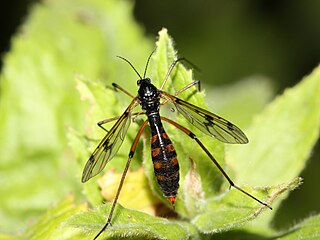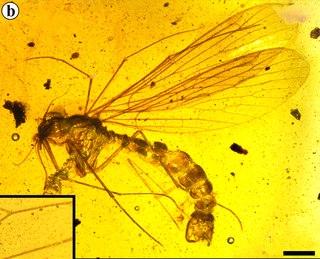
Tanyderidae, sometimes called primitive crane flies, are long, thin, delicate flies with spotted wings, superficially similar in appearance to some Tipulidae, Trichoceridae, and Ptychopteridae. Most species are restricted in distribution. They are found in many parts of the world, including North America, South America, Africa, Australia, New Zealand, and various islands in the Pacific Ocean. Adults are usually found hanging from vegetation near streams. Larvae are found either in sandy stream margins or in wet, rotten wood. Fossil species are known.

Bittacidae is a family of scorpionflies commonly called hangingflies or hanging scorpionflies.

The Ptychopteridae, phantom crane flies, are a small family of nematocerous Diptera. Superficially similar in appearance to other "tipuloid" families, they lack the ocelli of the Trichoceridae, the five-branched radial vein of the Tanyderidae, and the two anal veins that reach the wing margins of the Tipulidae. They are usually allied with the Tanyderidae based on similarities of the mesonotal suture, this group being called the Ptychopteromorpha.

Anaxyelidae is a family of incense cedar wood wasps in the order Hymenoptera. It contains only one living genus, Syntexis, which has only a single species, native to Western North America. Fossils of the family extend back to the Middle Jurassic, belonging to over a dozen extinct genera, with a particularly high diversity during the Early Cretaceous. Syntexis lay eggs in the sapwood of conifers, preferring recently burnt wood.

Osmylidae are a small family of winged insects of the net-winged insect order Neuroptera. The osmylids, also called lance lacewings, stream lacewings or giant lacewings, are found all over the world except North and Central America. There are around 225 extant species.

The Berothidae are a family of winged insects of the order Neuroptera. They are known commonly as the beaded lacewings. The family was first named by Anton Handlirsch in 1906. The family consists of 24 genera and 110 living species distributed discontinuously worldwide, mostly in tropical and subtropical regions. Numerous extinct species have also been described. Their ecology is poorly known, but in the species where larval stages have been documented, the larvae are predators of termites.

Coptoclavidae is an extinct family of aquatic beetles in the suborder Adephaga. The Coptoclavidae lived from the Late Triassic to the Early Cretaceous. Coptoclavidae is a member of the adephagan clade Dytiscoidea, which contains other aquatic beetles. Suggested reasons for their extinction to include the rise of teleost fish, or competition with Gyrinidae and Dytiscidae, which possess defensive secretions and sucking channels in the mandibles of larvae, which coptoclavids likely lacked. It has been suggested that the genus Timarchopsis and the subfamily Timarchopsinae are only distantly related to other coptoclavids based on cladistic analysis, with Timarchopsis being more closely related to geadephagans like carabids and trachypachids instead. Another study also suggested similarly for Coptoclavisca and possibly other coptoclaviscines.

Ithonidae, commonly called moth lacewings and giant lacewings, is a small family of winged insects of the insect order Neuroptera. The family contains a total of ten living genera, and over a dozen extinct genera described from fossils. The modern Ithonids have a notably disjunct distribution, while the extinct genera had a more global range. The family is considered one of the most primitive living neuropteran families. The family has been expanded twice, first to include the genus Rapisma, formerly placed in the monotypic family Rapismatidae, and then in 2010 to include the genera that had been placed into the family Polystoechotidae. Both Rapismatidae and Polystoechotidae have been shown to nest into Ithonidae sensu lato. The larvae of ithonids are grub-like, subterranean and likely phytophagous.
The Brachyceran family Kovalevisargidae is an extinct group of flies known from the Jurassic Daohugou biota of China and the Karabastau Formation of Kazakhstan.
Locustopsidae is an extinct family of grasshoppers in the order Orthoptera. There are about 17 genera and more than 60 described species in Locustopsidae.

Pseudopolycentropodidae is an extinct family of scorpionflies known from the Mesozoic. Fossils are known from the Middle Triassic (Anisian) to the early Late Cretaceous (Cenomanian). It is part of Mesopsychoidea, a group of scorpionflies with siphonate proboscis. They are suggested to have been nectarivores, feeding off the liquid pollination drops and acting as pollinators for now extinct insect pollinated gymnosperms such as Bennettitales.

Dermapteridae is an extinct family of earwigs known from the Late Triassic to Mid Cretaceous, it is part of the extinct suborder Archidermaptera, alongside Protodiplatyidae and Turanovia. It was first named as a subfamily by Vishniakova in 1980, and elevated to family status by Engel in 2003 without discussion.
Rhagionemestriidae is an extinct family of brachyceran flies known from the Jurassic and Cretaceous periods. It was first named as a subfamily of the Nemestrinidae by Ussatchov (1968), and was raised to full family status by Nagatomi and Yang (1998). They are considered to be closely related to the family Acroceridae. Similar to Acroceridae, members of the family possess a large hemispherical head, with eyes covering nearly all of the area.

Eremochaetidae is an extinct family of brachyceran flies known from the Jurassic and Cretaceous periods of Asia. It is part of the extinct superfamily Archisargoidea. The morphology of the ovipositor of the only 3 dimensionally preserved genus Zhenia was initially interpreted as evidence of being an endoparasitoid of arthropods, however a subsequent study suggested that the ovipositor was used to deposit its eggs in plant material, similar to members of Tephritoidea. In a phylogenetic analysis, Ermochaetidae was found to be monophyletic, surrounded by a paraphyletic Archisargidae.

Archisargidae is an extinct family of brachyceran flies known from the Jurassic and Cretaceous periods. It is part of the extinct superfamily Archisargoidea. Most members of the family are known from the Callovian-Oxfordian Daohugou biota of Inner Mongolia, China, and the equivalently aged Karabastau Formation of Kazakhstan. The family has been found to be paraphyletic with respect to Eremochaetidae in a cladistic analysis.
Fulgoridiidae are an extinct family of Mesozoic planthoppers. They are the earliest group of planthoppers known, and appear to be a paraphyletic assemblage ancestral to living planthoppers. The majority of known members of the family lived in the Jurassic period, though the group also includes one Cretaceous taxon. All currently known species are from Eurasia.
Praeaulacidae is an extinct family of Mesozoic parasitic wasps in the suborder Evanioidea. It among the earliest known families of the group and is characterised by more complete wing venation in comparison to other members of the suborder. It has been found that Othniodellithidae is nested within Praeaulacidae via cladistic analysis.
Mesochrysopidae is an extinct family of lacewings known from the Jurassic and Cretaceous periods. They are considered to be closely related to green lacewings of the family Chrysopidae. The family are also alternatively considered a paraphyletic grade leading up to crown Chrysopidae.

Necrotauliidae is an extinct family Mesozoic Amphiesmenoptera. While previously considered a paraphyletic grouping of "basal Trichoptera, basal Lepidoptera, and advanced stem-Amphiesmenoptera", they have recently been considered early diverging caddisflies. Other authors have considered them to be basal amphiesiopterans.

Orthophlebiidae is an extinct family of scorpionflies known from the Triassic to Cretaceous, belonging to the superfamily Panorpoidea. The family is poorly defined and is probably paraphyletic, representing many primitive members of Panorpoidea with most species only known from isolated wings, and has such been considered a wastebasket taxon.
















